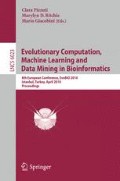Abstract
Modern genotyping techniques have allowed the field of human genetics to generate vast amounts of data, but analysis methodologies have not been able to keep pace with this increase. In order to allow personal genomics to play a vital role in modern health care, analysis methods capable of discovering high order interactions that contribute to an individual’s risk of disease must be developed. An artificial immune system (AIS) is a method which maps well to this problem and has a number of appealing properties. By considering many attributes simultaneously, it may be able to effectively and efficiently detect epistasis, that is non-additive gene-gene interactions. This situation of interacting genes is currently very difficult to detect without biological insight or statistical heuristics. Even with these approaches, at low heritability (i.e. where there is only a small genetic signal), these approaches have trouble distinguishing genetic signal from noise. The AIS also has a compact solution representation which can be rapidly evaluated. Finally the AIS approach, by iteratively developing an antibody which ignores irrelevant genotypes, may be better able to differentiate signal from noise than machine learning approaches like ReliefF which struggle at small heritabilities. Here we develop a basic AIS and evaluate it on very low heritability datasets. We find that the basic AIS is not robust to parameter settings but that, at some parameter settings, it performs very effectively. We use the settings where the strategy succeeds to suggest a path towards a robust AIS for human genetics. Developing an AIS which succeeds across many parameter settings will be critical to prepare this method for widespread use.
Access this chapter
Tax calculation will be finalised at checkout
Purchases are for personal use only
Preview
Unable to display preview. Download preview PDF.
References
Moore, J., Williams, S.: Epistasis and Its Implications for Personal Genetics. The American Journal of Human Genetics 85(3), 309–320 (2009)
Bateson, W.: Mendels principles of heredity. Molecular and General Genetics MGG 3(1), 108–109 (1910)
Fisher, R.: The correlation between relatives on the supposition of Mendelian inheritance. Transactions of the Royal Society of Edinburgh 52(2), 399–433 (1918)
Emily, M., Mailund, T., Hein, J., Schauser, L., Schierup, M.: Using biological networks to search for interacting loci in genome-wide association studies. European Journal of Human Genetics 1, 10 (2009)
De Castro, L., Timmis, J.: Artificial immune systems: a new computational intelligence approach. Springer, Heidelberg (2002)
Ritchie, M., White, B., Parker, J., Hahn, L., Moore, J.: Optimization of neural network architecture using genetic programming improves detection and modeling of gene-gene interactions in studies of human diseases. BMC Bioinformatics 4(1), 28 (2003)
Motsinger-Reif, A., Ritchie, M.: Neural networks for genetic epidemiology: past, present, and future. BioData Mining 1(1), 3 (2008)
Greene, C., White, B., Moore, J.: Ant colony optimization for Genome-Wide genetic analysis. In: Dorigo, M., Birattari, M., Blum, C., Clerc, M., Stützle, T., Winfield, A.F.T. (eds.) ANTS 2008. LNCS, vol. 5217, pp. 37–47. Springer, Heidelberg (2008)
Kononenko, I.: Estimating attributes: Analysis and extensions of RELIEF. In: Bergadano, F., De Raedt, L. (eds.) ECML 1994. LNCS, vol. 784, pp. 171–182. Springer, Heidelberg (1994)
McKinney, B.A., Reif, D.M., White, B.C., Crowe, J.E., Moore, J.H.: Evaporative cooling feature selection for genotypic data involving interactions. Bioinformatics 23(16), 2113–2120 (2007); PMID: 17586549
Beretta, L., Cappiello, F., Moore, J.H., Barili, M., Greene, C.S., Scorza, R.: Ability of epistatic interactions of cytokine single-nucleotide polymorphisms to predict susceptibility to disease subsets in systemic sclerosis patients. Arthritis and Rheumatism 59(7), 974–983 (2008); PMID: 18576303
McKinney, B.A., Crowe, J.E., Guo, J., Tian, D.: Capturing the spectrum of interaction effects in genetic association studies by simulated evaporative cooling network analysis. PLoS Genetics 5(3), e1000432 (2009); PMID: 19300503
Kira, K., Rendell, L.A.: A practical approach to feature selection. In: ML 1992: Proceedings of the ninth international workshop on Machine learning, pp. 249–256. Morgan Kaufmann Publishers Inc., San Francisco (1992)
Bereta, M., Burczynski, T.: Comparing binary and real-valued coding in hybrid immune algorithm for feature selection and classification of ECG signals. Engineering Applications of Artificial Intelligence 20(5), 571–585 (2007)
Author information
Authors and Affiliations
Editor information
Editors and Affiliations
Rights and permissions
Copyright information
© 2010 Springer-Verlag Berlin Heidelberg
About this paper
Cite this paper
Penrod, N.M., Greene, C.S., Granizo-MacKenzie, D., Moore, J.H. (2010). Artificial Immune Systems for Epistasis Analysis in Human Genetics. In: Pizzuti, C., Ritchie, M.D., Giacobini, M. (eds) Evolutionary Computation, Machine Learning and Data Mining in Bioinformatics. EvoBIO 2010. Lecture Notes in Computer Science, vol 6023. Springer, Berlin, Heidelberg. https://doi.org/10.1007/978-3-642-12211-8_17
Download citation
DOI: https://doi.org/10.1007/978-3-642-12211-8_17
Publisher Name: Springer, Berlin, Heidelberg
Print ISBN: 978-3-642-12210-1
Online ISBN: 978-3-642-12211-8
eBook Packages: Computer ScienceComputer Science (R0)

